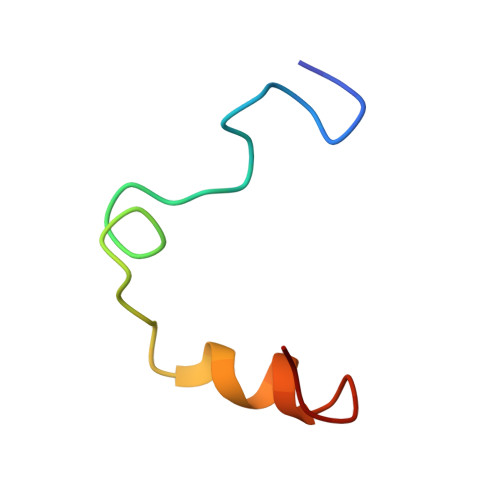The isomorphous structures of prethrombin2, hirugen-, and PPACK-thrombin: changes accompanying activation and exosite binding to thrombin.
Vijayalakshmi, J., Padmanabhan, K.P., Mann, K.G., Tulinsky, A.(1994) Protein Sci 3: 2254-2271
- PubMed: 7756983
- DOI: https://doi.org/10.1002/pro.5560031211
- Primary Citation of Related Structures:
1HAG, 1HAH, 1HAI - PubMed Abstract:
The X-ray crystal structure of prethrombin2 (pre2), the immediate inactive precursor of alpha-thrombin, has been determined at 2.0 A resolution complexed with hirugen. The structure has been refined to a final R-value of 0.169 using 14,211 observed reflections in the resolution range 8.0-2.0 A. A total of 202 water molecules have also been located in the structure. Comparison with the hirugen-thrombin complex showed that, apart from the flexible beginning and terminal regions of the molecule, there are 4 polypeptide segments in pre2 differing in conformation from the active enzyme (Pro 186-Asp 194, Gly 216-Gly 223, Gly 142-Pro 152, and the Arg 15-Ile 16 cleavage region). The formation of the Ile 16-Asp 194 ion pair and the specificity pocket are characteristic of serine protease activation with the conformation of the catalytic triad being conserved. With the determination of isomorphous structures of hirugen-thrombin and D-Phe-Pro-Arg chloromethyl ketone (PPACK)-thrombin, the changes that occur in the active site that affect the kinetics of chromogenic substrate hydrolysis on binding to the fibrinogen recognition exosite have been determined. The backbone of the Ala 190-Gly 197 segment in the active site has an average RMS difference of 0.55 A between the 2 structures (about 3.7 sigma compared to the bulk structure). This segment has 2 type II beta-bends, the first bend showing the largest shift due to hirugen binding. Another important feature was the 2 different conformations of the side chain of Glu 192. The side chain extends to solvent in hirugen-thrombin, which is compatible with the binding of substrates having an acidic residue in the P3 position (protein-C, thrombin platelet receptor). In PPACK-thrombin, the side chain of Asp 189 and the segment Arg 221A-Gly 223 move to provide space for the inhibitor, whereas in hirugen-thrombin, the Ala 190-Gly 197 movement expands the active site region. Although 8 water molecules are expelled from the active site with PPACK binding, the inhibitor complex is resolvated with 5 other water molecules.
- Department of Chemistry, Michigan State University, East Lansing 48824-1322, USA.
Organizational Affiliation:



















